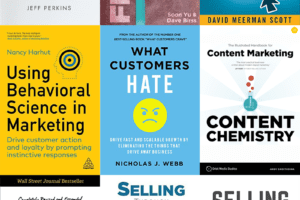???? Episode 99 of Yes, and Marketing
A picture is worth 1000 words, even on a podcast.
That’s just one of the things we learned from talking with Dan White. Dan is a marketer, illustrator, and brand consultant, whose current focus is on spreading marketing ideas through illustrations. He’s also the author of The Smart Marketing Book, which includes ideas and insights drawn from Dan’s 30 years of experience in the field and is one of the most engaging and easy-to-read business books we have ever come across. Doug Burdett, host of the Marketing Book Podcast, even called it the best practical book that should serve as your marketing bible.
In this interview, Dan explains a few of his marketing illustrations, in addition to covering growth strategies, branding, what makes for successful innovation, and the role of content in marketing.
Listen to the full interview above or read on for our highlights from the conversation. Want more Dan illustrations? Check out his website (linked below) to view and download his original images.
???? Guest-at-a-Glance
Name: Dan White
What he does: Marketer, author, and illustrator.
Find Dan on the web: Smart Marketing | LinkedIn | Twitter
Get smart: “If there’s one thing you need to do as a marketer, it’s getting the brand to come to mind when people are thinking about buying the category.”
???? Top Takeaways
Know how to grow
Dan talks about the Ansoff Growth Strategy Matrix, which helps determine which of four paths you should take to grow your business. On one axis, you choose whether to focus on your existing products or services, or to create new ones. The other axis distinguishes between focusing on your existing market—whether that’s a target audience or geography—or expanding into new ones.
Dan says, “If you’re in a market selling your existing products and you’ve got a lot of headroom, then continue doing that for now. Continue to increase penetration within your current universe, your current market, using existing products. That’s step one.”
If, however, you’ve got a product that’s doing well in your market and is clearly superior to your competitors, the next step is identifying whether there are other markets where it would do equally well and expanding into those.
As for the other axis, Dan explains, there can be a risk to your brand when creating new products if they’re not the right ones. “A product development strategy should be when you’ve got more ideas for products that will be equally superior to your existing products,” he clarifies.
The Marketing Mix Eye
“The concept here is that to drive purchase, brands need two aspects of marketing,” Dan explains.
The first of those is brand predisposition: “People are predisposed to a brand. It doesn’t mean they’re necessarily going to buy it or not, but they’re predisposed to buying it,” he says. “You can build that predisposition in a number of ways. You can build it through advertising, paid advertising, owned media, earned media—if people say nice things about your product, that makes people more predisposed to buy it.”
The second aspect is path to purchase: “It’s a competitive world out there and there’s a lot of distractions and a lot of alternatives that people can choose instead of your brand, and they might choose another brand—even if they’re predisposed to yours—if your path to purchase isn’t strong,” he explains. The path to purchase includes things like being available where your customer is looking to buy, being noticed, your pricing, etc.
Finally, once an initial purchase has been made, the feedback loop becomes the most important part of the puzzle: “Once you actually purchase and therefore experience the actual product, that becomes the most influential factor in terms of future predisposition or not,” Dan says. “If it’s great, fantastic. If it’s not a good product, forget it.”
A checklist for innovation
“The innovation gem is meant to be a framework that helps people figure out whether an innovation is likely to be successful or not,” Dan says.
He compares a brand to a potential hire. “A product could be designed to do a job very well—perfectly hireable, if you like—but you are not necessarily going to be hired as a brand to do that job if you’re not noticed, you’re not available, you’re not unique,” he explains.
“So, there are other things you need to do also to be successful. One is, are you relevant to do the job? Do you have the credentials? Are you compelling? Are you charismatic? So when you’re being hired to do the job, do you come across well in the interview? And of course, do you do a good job? That’s why I call satisfying—do you satisfy the need, or are you so bad you’ll get fired?”
???? Episode Highlights
Read verbatim excerpts from our interview with Dan White.
Dan’s definition of marketing
“My definition is to create, promote and deliver products or services that enable commercial objectives to be met through the customer value they generate.
…Some people think of marketing as the function—as in, within a company, there’s usually a marketing team or a marketing function, and they do certain things. But actually, the whole organization is involved in marketing in the sense of trying to figure out what it is that a certain group of customers somewhere might value, and that you can make money out of because you can deliver something that they value. So for me, marketing is that bigger definition.”
Most brands aren’t special
“I think a lot of brand owners believe that their brand is more special than it actually is—more different, more better, when it might not be that much better or actually not tangibly different, really—and therefore they kind of expect too much.
They expect that sales will come, whereas I think actually you need to create that kind of special-ness quite often. In a lot of categories and a lot of markets, brands aren’t that special, but you can make them feel different and feel special—or, even if they do not feel different, they can be distinctive.”
Experience is the most important part of brand
“The way I like to define a brand is, it’s everything that comes to mind when people think of the brand. Whatever associations, thoughts, feelings, colors, opinions—they all just come flooding in and you can’t separate them.
…If you think of the brand as that set of associations and feelings, there are lots of factors in it, and advertising is one of those, for example, but the experience of the product is the biggest, the most powerful.”
His prediction for the future of marketing
“What’s going to fundamentally change about marketing? Almost certainly nothing. You know, Kotler’s four Ps—they’re not going to change. They can’t. They’re too fundamental, they’re too true. It’s just the way those things need to be leveraged that keeps changing, through technology mainly.”
His contrarian marketing advice
“Stop focusing most of your people on profit. Try and get a few people focusing on worrying about profit, but get most other people focusing on delivering efficiently and delivering a great brand, a great experience.”
????️ Dan White Quotes
“If an organization can’t create value for its customers, it’s gonna be very hard for them to deliver profit.”
“The thing about any great innovation is, if you can’t protect it, you’re going to get copied—unless you’re quick.”
“If there’s one thing you need to do as a marketer, it’s getting the brand to come to mind when people are thinking about buying the category.”
“Customer experience is usually the biggest driver of—not always, but usually—the biggest driver of brand perceptions and brand health.”
“Content marketing is one thing, but more importantly it’s how are you going to get eyeballs or for people to experience it?”
“Breakthrough, amazing creativity that captures the public’s imagination—that’s when you get phenomenal growth, versus just incremental, a few points here and there.”
“You have to change your strategy in advance of it stopping working.”
???? Learn More
Learn more about Alan Baddely’s model of working memory.
Dan cited Fredrik Hallberg, a marketing consultant in Stockholm, who defines marketing as “the science of exploring, creating, and delivering value to satisfy the needs of a market at a profit.”
Dan and Steve also discussed Clay Christensen’s “Jobs to Be Done” framework.
Check out Byron Sharp and Mark Ritson, two marketers Dan follows.



